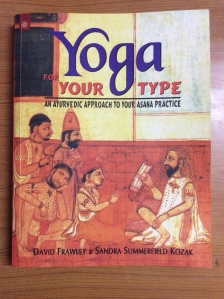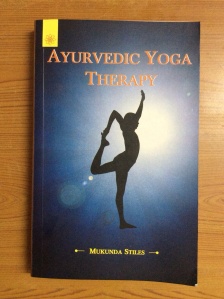Ayurveda and Yoga
Ayurveda is the Vedic science of healing for both body and mind, developed in ancient India around 1500 BC. The word means “wisdom of life”. It’s a vast subject, and I like the way it’s summarized in the book, Yoga for Your Type – An Ayurvedic Approach to Your Asana Practice (David Frawley and Sandra Summerfield Kozak):
 “We develop disease because of two factors that usually go together: externally, a wrong relationship with environmental forces like food or climate and, internally, a wrong movement of internal energies brought about by disharmonious thoughts and emotions”. It’s an excellent book, as is Mukunda Stiles’ Ayurvedic Yoga Therapy. [[Update: 1 October: many people have asked me where to find these books. My photos show covers printed in India, but if you click on the links, you’ll find the same books online, even if the covers look different.]]
“We develop disease because of two factors that usually go together: externally, a wrong relationship with environmental forces like food or climate and, internally, a wrong movement of internal energies brought about by disharmonious thoughts and emotions”. It’s an excellent book, as is Mukunda Stiles’ Ayurvedic Yoga Therapy. [[Update: 1 October: many people have asked me where to find these books. My photos show covers printed in India, but if you click on the links, you’ll find the same books online, even if the covers look different.]]
Today, Ayurveda is emerging as one of the most important systems of mind-body medicine in the world. Its treatment of disease prevention and cure is based on key lifestyle changes, individualized diet, herbal formulas and a spiritual focus of Yoga and meditation.
The practice of Ayurveda first identifies our body types and behaviours into three different categories, or “doshas”: Vata, Pitta, and Kapha. We’re typically a blend of all three constitutions, with one more prevalent than the others, and when all three are in a balanced state, we naturally choose what is good for us in terms of diet and lifestyle.
When they’re out of balance … Look out! A cocktail of fear, anxiety, panic attacks, rage, impatience, criticism, laziness or lack of motivation follows, depending on what your dosha is. And guess what a major culprit is for imbalance of the constitutions? Diet and the digestive system. We’ve heard this so many times during the past 3 weeks, it’s like a broken record. We just keep coming back to the logic of You Are What You Eat, and Your Body Is A Temple.
“Food is that which you eat, as well as that which eats you” – Anonymous
When we eat without awareness, shoving the wrong food into our bodies at the wrong times of the day or night, we place stress on the systems of the body as it attempts to balance hormones, digest and eliminate toxins.
Not surprisingly, Yoga and Ayurveda are a perfect match.
“Yoga and Ayurveda belong to each other like a brother to a sister, the breath to the body, a plant in its soil”. – Mukunda Stiles
There are specific yoga poses, breathing techniques and meditation types that vary for each of the three dosha types. It’s ironic how a Vata-dominant person who is out of balance will often seek a fast, active and potentially harmful style of yoga, when what that constitution really needs is more meditation and a gentler yoga practice; holding the poses for longer. Or a Pitta-dominant person will benefit more from shorter holds without strain, but when they’re out of balance they’ll tend to overdo it, pushing their bodies too much with over-enthusiastic intensity. And a Kapha-dominant person when out of balance would like to lie around on restorative yoga boulsters or dedicate their yoga time to kirtan chanting, when they would get more out of a regular and active yoga practice.
Yogi Sivadas tells us that when we live a healthy and balanced “Sattvic” (clean) life – in diet, lifestyle, exercise, attitude and meditation, we will create an environment for a happy body and a calm mind. And if you can’t live this totally Sattvic life, obeying every single discipline? He’s in favour of the 80/20 rule; being pure and clean 80% of the time and allowing yourself indulgences 20% of the time, making those choices with awareness.
And as it’s getting late and I’ve already eaten a bar of Cadburys chocolate tonight, I would like to keep in line with the circadian rhythms of the body, so I’m heading to bed for a good night’s sleep!




Love the idea of the 80/20 rule! I have tried 100% and find that I can’t function in the social world with family and friends!
I’m going to be bringing that 80/20 advice home – as you know, I usually apply it, but in the reverse!!
This is a great and concise introduction to Ayurveda. What I think is fascinating is the Ayurveda and Traditional Chinese Medicine and Shamanic Healing Practices were developed thousands of years ago, before there were any medical devices for experimentation and assessment. Now, these practices and principles are being studied and modern investigation is proving that these ancient healers knew as much, if not more, than we do now about health, healing and maintaining vitality and balance. Thanks for sharing!
Thanks for your comments, Kristin. So true. Yogi Sivadas spoke about Ayurveda as a science which is based on thousands of years of experience through observation, not experimentation as we do with today’s drugs/medication. As they observed recurring patterns and saw how health was affected by specific diet and lifestyle choices, so it was documented and then further refined as they gained more knowledge. It’s a vast subject which I’ve only just started exploring and so much of it is common sense! It’s also enjoying renewed popularity in India and I’m intrigued and inspired to study it in more detail.